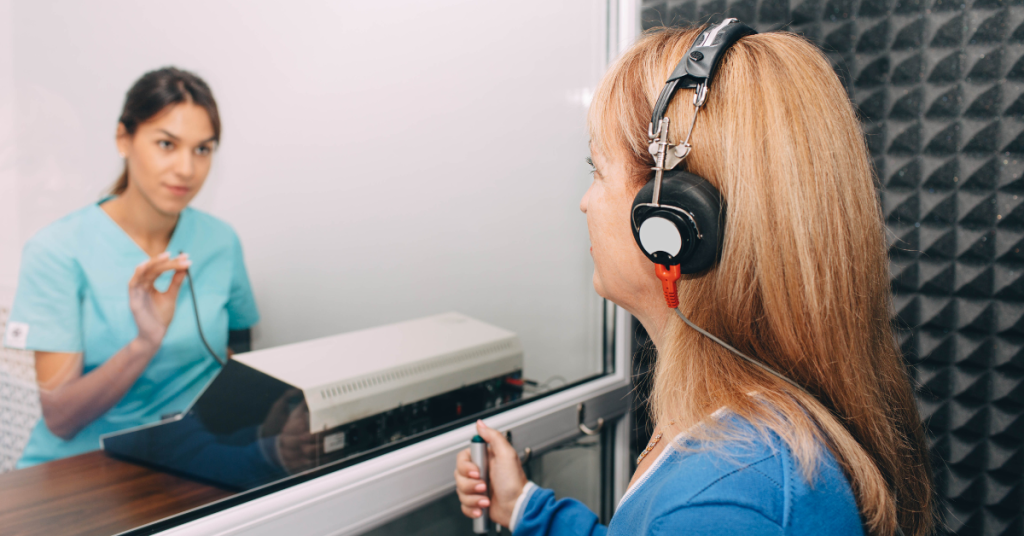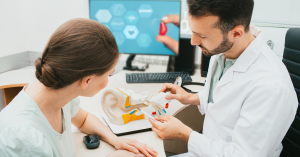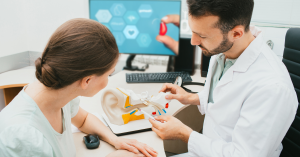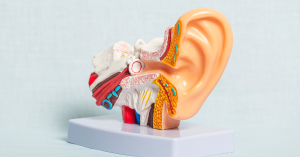When it comes to understanding hearing loss, not all tests are created equal. If you’ve ever had a hearing evaluation—or are considering one—you’ve probably heard terms like pure tone audiometry and speech audiometry. These two tests are the backbone of most hearing assessments, yet many people don’t fully understand what they measure or how they differ.
Pure tone and speech audiometry serve distinct but complementary purposes. One focuses on detecting the faintest sounds you can hear, while the other evaluates how well you can recognize and understand spoken words. Knowing the difference between these two tests can help demystify your hearing test results and empower you to make informed decisions about your hearing health.
In this article, we’ll walk you through both types of hearing tests, explain how they’re conducted, and show why each plays a vital role in diagnosing hearing issues. Whether you’re experiencing hearing changes yourself or supporting a loved one, understanding these tools is the first step toward clearer communication and better hearing care.
What Is Pure Tone Audiometry?
Pure tone audiometry is one of the most common and foundational tests used to evaluate hearing. If you’ve ever been inside a soundproof booth wearing headphones and pressing a button when you hear a beep, you’ve likely undergone this test. It’s a straightforward yet powerful way to measure your hearing thresholds—the quietest sounds you can hear at various frequencies.
During the test, you’re presented with a series of tones that vary in pitch (frequency) and loudness (intensity). These tones are played through headphones or insert earphones, one ear at a time. Your job is to indicate when you can hear each sound, no matter how faint. The softest level at which you consistently respond to a tone at a particular frequency is recorded as your hearing threshold.
The results are plotted on a graph called an audiogram, which shows your hearing sensitivity across different frequencies, typically ranging from 250 Hz to 8000 Hz. These frequencies are important because they encompass the range of sounds most relevant to human speech.
Pure tone audiometry can reveal:
- Whether you have hearing loss
- The degree of hearing loss (mild, moderate, severe, or profound)
- The type of hearing loss (conductive, sensorineural, or mixed)
For example, if the tones must be played louder than normal before you hear them, this suggests a hearing deficit. If only certain frequencies are affected—like high-pitched sounds—it might explain why you struggle to hear birds chirping or understand voices in a crowded room.
The simplicity and precision of pure tone audiometry make it a go-to tool for audiologists. It offers a reliable way to quantify hearing ability and identify patterns that may point to specific causes of hearing loss. However, it doesn’t assess how well you understand spoken language, which is where speech audiometry comes in.
What Is Speech Audiometry?
While pure tone audiometry measures your ability to detect sound, speech audiometry evaluates how well you hear and understand spoken words—a crucial part of everyday communication. This test gives audiologists insight into how your hearing loss affects your ability to comprehend language, especially in real-world environments.
Speech audiometry typically consists of two main components:
- Speech Reception Threshold (SRT):
This part of the test determines the softest level at which you can correctly repeat 50% of familiar two-syllable words (called spondees), such as “baseball” or “hotdog.” The SRT helps verify the accuracy of your pure tone test and ensures the hearing thresholds align with how you perceive speech. - Word Recognition Score (WRS):
Also known as speech discrimination testing, WRS assesses how well you can understand and repeat single-syllable words presented at a comfortable volume—usually 30–40 decibels above your SRT. You might hear words like “fish,” “book,” or “house” and be asked to repeat them. Your score is calculated as the percentage of words you repeat correctly.
Unlike pure tone testing, speech audiometry is more reflective of real-life listening situations. For instance, someone with a high WRS likely understands speech well when it’s loud enough, while someone with a low WRS may struggle with clarity even if volume isn’t an issue—something hearing aids alone can’t always fix.
Some audiologists also conduct speech-in-noise tests, where words or sentences are presented alongside background noise to simulate environments like restaurants or busy streets. These results can be incredibly helpful in guiding hearing aid programming and setting realistic expectations for how much improvement amplification can provide.
Speech audiometry results help:
- Pinpoint how well you process spoken language
- Guide the selection and fitting of hearing aids
- Determine the potential benefit of auditory rehabilitation or speech therapy
By combining speech audiometry with pure tone results, audiologists can build a more complete profile of your hearing abilities, leading to better treatment outcomes.
Key Differences Between Speech Audiometry and Pure Tone Testing
Although both speech audiometry and pure tone testing are integral parts of a comprehensive hearing evaluation, they serve very different purposes and assess different aspects of your auditory system. Understanding how they differ can help you better interpret your test results and know what to expect during your appointment.
Purpose and Focus
- Pure Tone Testing focuses on detecting the softest sounds you can hear across various frequencies. It identifies the thresholds of hearing sensitivity, which helps determine the degree and type of hearing loss.
- Speech Audiometry, on the other hand, evaluates how well you can understand and repeat spoken words. It reveals how your hearing loss affects real-life communication, especially in noisy environments.
In simple terms, pure tone audiometry tells us what you can hear, while speech audiometry tells us how well you understand what you hear.
Testing Method
- In pure tone audiometry, you’re played a series of beeps (tones) through headphones and asked to indicate when you hear them. The test is conducted in a soundproof booth to eliminate background noise and isolate each ear.
- In speech audiometry, you listen to recorded or live speech—usually through the same headphones—and repeat the words you hear. Depending on the test, the volume and clarity of the speech may vary.
The process is a bit more interactive during speech testing since it involves repeating words back, which requires not just hearing but also processing and recalling the sounds.
Information Provided
- Pure tone results are displayed on an audiogram, showing your hearing ability across a range of frequencies. It helps identify high-frequency or low-frequency hearing loss and guides decisions like hearing aid programming.
- Speech audiometry results are often given as percentages (Word Recognition Scores) and thresholds (Speech Reception Thresholds), which help determine how clearly you perceive spoken language, especially in quiet or noisy conditions.
While someone may have relatively mild hearing loss on a pure tone test, their speech recognition could still be poor—especially if there’s inner ear or auditory nerve damage. That’s why both tests are crucial.
Clinical Importance
Together, these tests provide a fuller picture:
- Pure tone audiometry sets the baseline for hearing sensitivity.
- Speech audiometry determines functional hearing ability—how well someone communicates in daily life.
Audiologists use both sets of results to create a tailored treatment plan, decide on hearing aid types and settings, or recommend other interventions like auditory training or cochlear implants.
Why Both Tests Are Important for a Complete Hearing Assessment
Hearing is about more than just detecting sound—it’s about understanding and interpreting it. That’s why audiologists use both pure tone audiometry and speech audiometry during a hearing assessment. While each test offers valuable information on its own, together they provide a much more complete picture of your hearing health.
Complementary Insights
Pure tone testing measures the thresholds at which you begin to hear sounds. It tells your audiologist where your hearing is most and least sensitive across a range of frequencies. But it doesn’t explain how well you interpret what you hear. That’s where speech audiometry comes in.
Speech audiometry assesses your ability to process and comprehend spoken language. It reveals whether your hearing loss affects clarity, not just volume. For example, two people might have the same pure tone results, but vastly different word recognition scores. One may understand speech well with amplification, while the other may still struggle due to inner ear or nerve damage.
Guiding Treatment Decisions
When both tests are used together, they help:
- Confirm diagnosis: Speech audiometry results often validate findings from pure tone testing, ensuring accurate diagnosis.
- Customize hearing aids: If your speech understanding is poor, your audiologist can program hearing aids to enhance specific speech sounds or recommend more advanced technology.
- Set realistic expectations: Patients with low word recognition scores may not benefit fully from amplification alone and could need other interventions like auditory training.
- Monitor changes over time: Both tests can be repeated periodically to track the progression of hearing loss or evaluate how well treatments are working.
Real-World Relevance
You don’t live in a soundproof booth—your daily hearing challenges include conversations, background noise, and rapid speech. Speech audiometry simulates these real-world scenarios and gives a clearer view of how your hearing loss impacts your everyday life. Pure tone audiometry, while more clinical, establishes the foundation of your hearing profile.
By combining these tools, audiologists ensure no aspect of your hearing is overlooked. This comprehensive approach leads to more effective solutions and, ultimately, better communication and quality of life.
What to Expect During Your Hearing Test
If you’re preparing for a hearing test, it’s normal to feel a bit uncertain—especially if it’s your first time. Knowing what to expect can make the experience more comfortable and help you get the most accurate results. A full hearing evaluation usually includes both pure tone audiometry and speech audiometry, and it’s a painless, non-invasive process that typically takes 30 to 60 minutes.
Before the Test
When you arrive, the audiologist or hearing specialist will begin by asking about your hearing history. They may inquire about:
- Any noticeable hearing changes or challenges
- Exposure to loud noises
- Medical history (including ear infections or medications)
- Symptoms like tinnitus (ringing in the ears) or balance issues
This conversation helps tailor the evaluation to your specific needs and ensures the tests provide the most relevant information.
The Pure Tone Test
You’ll be seated in a soundproof booth and given headphones or soft insert earphones. Sometimes, a small device called a bone oscillator is also placed behind your ear to assess how sound travels through your skull bones.
The audiologist will play a series of tones at different pitches and volumes, one ear at a time. Your job is simple: raise your hand or press a button each time you hear a sound—even if it’s very faint. The goal is to find the quietest sound you can hear at various frequencies. This determines your hearing thresholds and is plotted on an audiogram.
The Speech Audiometry Test
Next, you’ll listen to spoken words or sentences through the same headphones. In the Speech Reception Threshold (SRT) part, you’ll be asked to repeat two-syllable words at decreasing volumes to find the softest level at which you can understand speech.
In the Word Recognition Score (WRS) portion, words will be presented at a comfortable loudness level, and you’ll repeat them back as clearly as you can. This tests how accurately you can identify and process speech. Some clinics also offer speech-in-noise tests, where background noise is added to better simulate real-life environments.
After the Test
Once the testing is complete, the audiologist will go over your results with you. They’ll explain your audiogram, discuss how well you understood the speech materials, and talk about what it all means for your hearing.
If hearing loss is detected, they’ll recommend next steps, which may include hearing aids, follow-up evaluations, or referrals to a medical specialist if there are signs of an underlying condition.
Helpful Tips
- Bring a list of any medications you’re taking
- Note any specific hearing difficulties or environments where you struggle
- Don’t be afraid to ask questions—understanding your results is key to getting the best care
A hearing test is a vital first step toward improving your communication and quality of life. By understanding how the process works, you’ll be better prepared to take control of your hearing health.
Conclusion
Hearing is an essential part of how we connect with the world—and when it starts to decline, so does our ability to engage in conversations, enjoy social interactions, and feel confident in everyday situations. That’s why accurate, comprehensive hearing assessments are so important. Understanding the difference between pure tone audiometry and speech audiometry can help demystify the testing process and empower you to make informed choices about your hearing health.
Pure tone audiometry lays the foundation by determining your hearing sensitivity at different frequencies. It identifies the presence, degree, and type of hearing loss. Speech audiometry adds a functional layer by assessing how well you recognize and process spoken words, giving a clearer picture of how your hearing loss affects your daily life.
Together, these tests provide a well-rounded view of your auditory system—something neither could achieve alone. Whether you’re just starting to notice hearing difficulties or supporting a loved one through the journey, knowing what each test offers helps you advocate for the best care possible.
If you’re due for a hearing checkup or have never had one, don’t put it off. Early detection makes a world of difference, and modern solutions—from hearing aids to auditory therapy—are more effective and accessible than ever. Talk to a qualified audiologist and take that first step toward better hearing and a more connected life.
FAQ
What is the main difference between pure tone audiometry and speech audiometry?
Pure tone audiometry measures your ability to hear sounds at various pitches and volumes, determining your hearing threshold across frequencies. Speech audiometry, on the other hand, assesses how well you understand and repeat spoken words, giving insight into how hearing loss affects real-life communication.
Can you have normal pure tone results but poor speech understanding?
Yes. It’s possible to have hearing thresholds within normal limits but still struggle to understand speech, especially in noisy environments. This may indicate issues with auditory processing or damage to the inner ear or auditory nerve, which speech audiometry can help identify.
Why do audiologists perform both tests during a hearing evaluation?
Each test provides unique information. Pure tone testing identifies the presence and type of hearing loss, while speech audiometry reveals how that hearing loss impacts your ability to communicate. Together, they offer a comprehensive view of your hearing health.
How accurate are speech audiometry and pure tone tests?
When administered by a licensed audiologist in a controlled environment, both tests are highly reliable. They are standardized procedures used globally to diagnose hearing conditions and guide treatment decisions, such as hearing aid selection and programming.
Do I need to prepare for a hearing test?
No special preparation is required. However, it’s helpful to bring a list of current medications and any notes about hearing difficulties you’ve experienced. If you wear hearing aids, bring them along as well, even if you’re being tested without them.
“This article is for informational purposes only and is not a substitute for professional medical advice, diagnosis, or treatment. If you are concerned about your hearing or ear health, please consult a qualified healthcare provider.”






